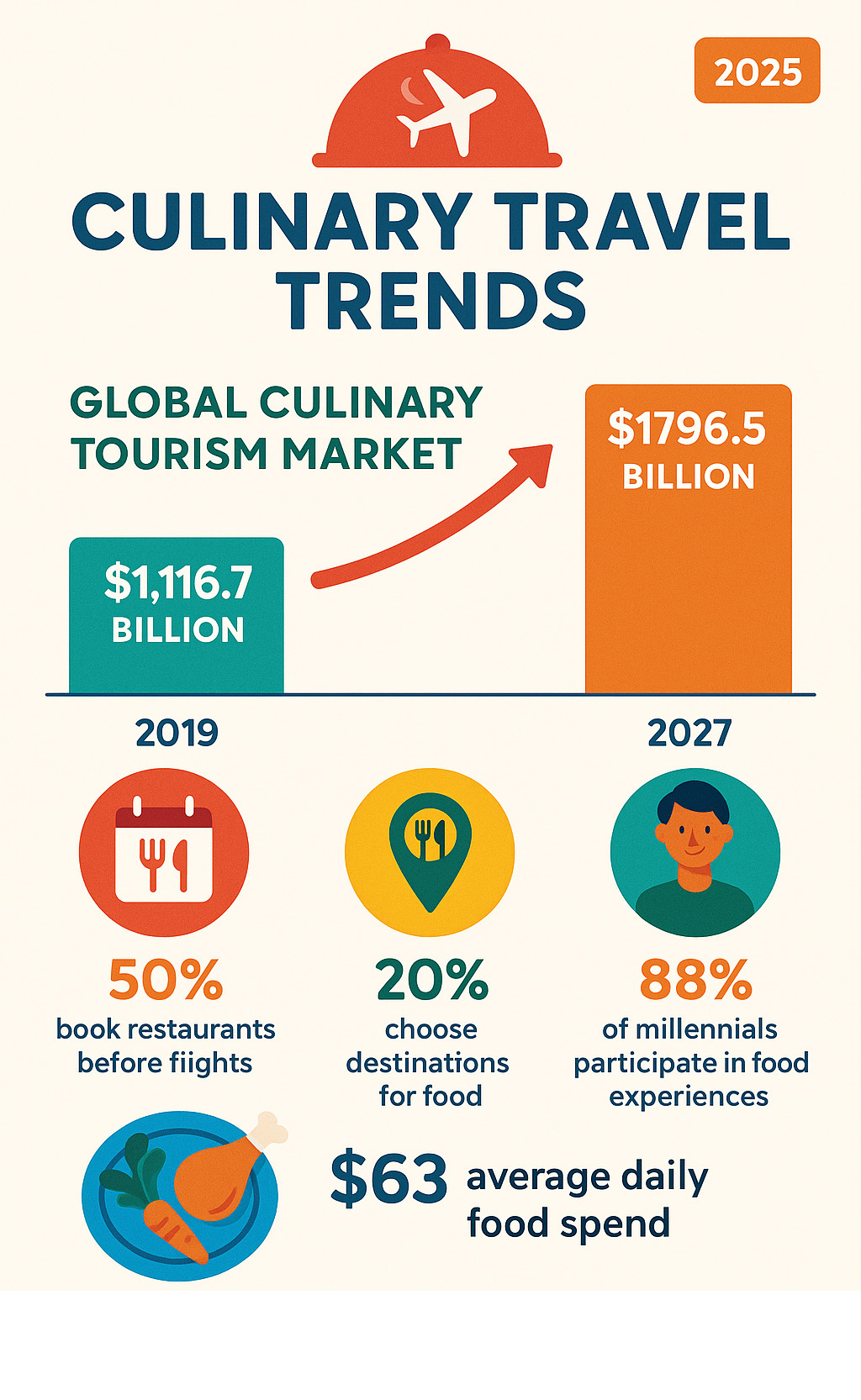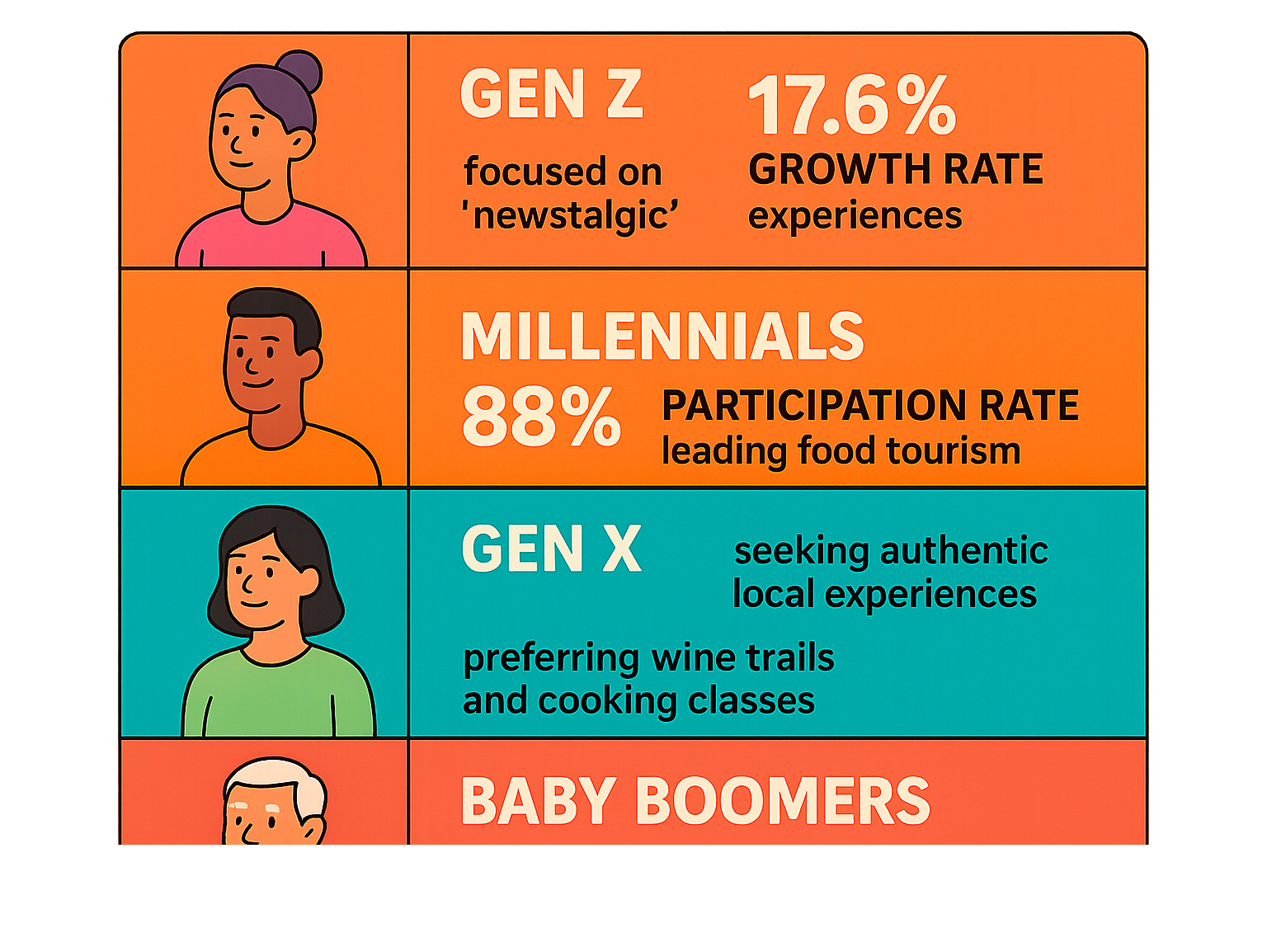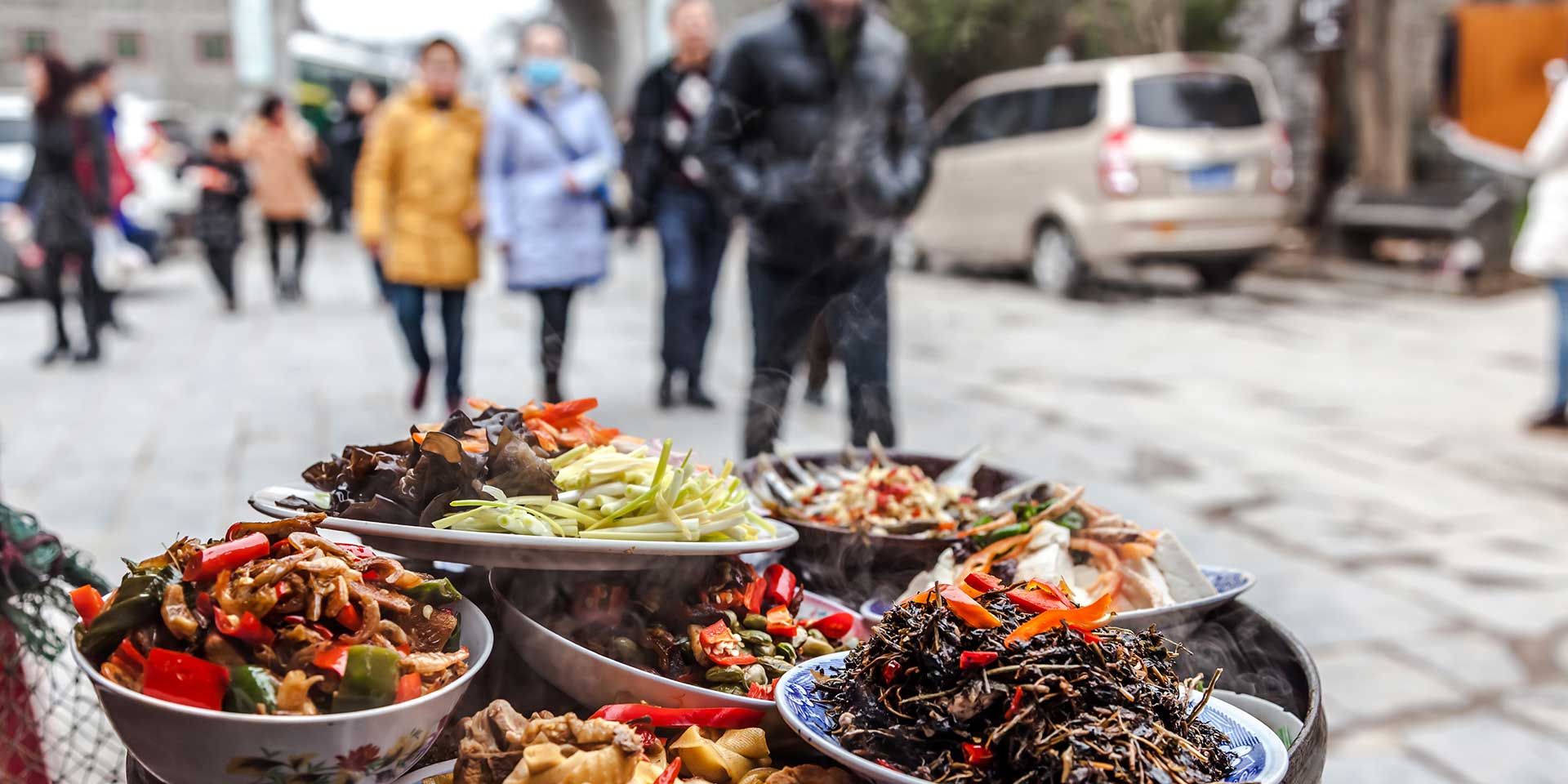Why Food Is Becoming the New Destination
Culinary travel trends are reshaping how we explore the world, with food experiences now driving destination choices more than traditional sightseeing. In 2025, nearly 20% of travelers choose their destinations based on culinary offerings, while 50% book restaurant reservations before securing their flights.
Key Culinary Travel Trends for 2025:
- Hyperlocal sourcing – 85% of restaurants adopting local ingredients
- Zero-waste kitchens – 72% implementing sustainable practices
- Plant-based cuisine – Wellness-driven gastronomy on the rise
- Immersive cooking retreats – Multi-day culinary education experiences
- AI-powered dining – Personalized restaurant recommendations
- Street food renaissance – Michelin-rated vendors gaining popularity
- Set-jetting eats – Food tourism inspired by TV shows and movies
The numbers tell a compelling story. 81% of travelers are most excited about trying local foods, and 88% of millennials have participated in food-related experiences while vacationing. With travelers spending an average of $63 per person per day on dining, food has moved from a travel necessity to the main attraction.
This shift represents what experts call the “taste of place” phenomenon – where authentic culinary experiences provide deeper cultural connections than traditional tourist activities. From Bangkok’s night markets to Tuscany’s cooking classes, food tourism is projected to grow at 7.6% annually through 2030, making it the fastest-growing segment in luxury travel.

Handy Culinary travel trends terms:
– Best food destinations
– World cuisine exploration
– food tourism technology
Culinary Tourism 2025: Definition, Market Boom & Traveler Behavior
Picture this: you’re scrolling through your phone, and suddenly you see a friend’s Instagram story featuring steaming bowls of pho from a tiny street stall in Vietnam. Within minutes, you’re not just hungry – you’re planning your next vacation around that exact food experience. Welcome to culinary travel trends, where a single dish can spark an entire journey.
The World Food Travel Association puts it beautifully: food tourism is “the act of traveling for a taste of place in order to get a sense of place.” It’s not just about eating – it’s about understanding a culture through its flavors, techniques, and dining rituals.
And boy, are travelers embracing this idea. 20% of people now choose their destinations specifically for the food, while a whopping 50% book restaurant reservations before they even secure their flights. Think about that for a moment – the restaurant reservation comes first, then the plane ticket. That’s how much food matters to today’s travelers.
The numbers keep getting more impressive. 81% of travelers actively seek out local dishes they’ve never tried before, and 88% of millennials have participated in food-related experiences during their vacations. We’re talking about everything from cooking classes in Tuscany to street food tours through Bangkok’s night markets.
Here’s where it gets really interesting: travelers are spending an average of $63 per person per day on food and dining experiences. That’s not just grabbing a quick bite – that’s serious investment in culinary exploration. Food has jumped from being a travel necessity to being the main event.
Social media has become the ultimate culinary travel agent, creating what experts call “food FOMO.” When everyone’s posting their amazing meals online, it creates this beautiful cycle where one person’s dinner becomes another person’s travel inspiration. Food photography has become the new cultural currency – a way to show you’re adventurous and sophisticated.
There’s also something magical about what researchers call “time-oasis dining.” In our rush-everywhere world, sharing a meal naturally slows us down. Unlike speed-walking through museums, dining creates space for genuine connections – with locals, with travel companions, and with the culture itself.
The shift is so dramatic that traditional tourism priorities are flipping upside down. Where travelers once allocated most of their budget to sightseeing, many now prioritize restaurant experiences over tourist attractions. It’s not about checking landmarks off a list anymore – it’s about creating meaningful memories around the dinner table.
Culinary Travel Trends 2025
The culinary travel trends shaping 2025 go far beyond simply trying new foods. They represent a complete reimagining of how we connect with places through our taste buds and dining experiences.
Multisensory dining experiences are changing restaurants into theatrical stages. In Barcelona, molecular gastronomy venues turn meals into performance art, while Tokyo’s blind-tasting dinners challenge diners to steer flavors without sight. These experiences create memories that last long after the last bite, proving that the best meals engage all our senses.
The plant-based cuisine movement has evolved from dietary restriction to culinary trip. Bali’s Ubud region leads with innovative vegan cafes and raw food retreats that feel indulgent rather than limiting. California’s Napa Valley shows how plant-forward dining can be both luxurious and deeply satisfying. This trend reflects travelers’ growing awareness of health and environmental impact.
Hyperlocal sourcing has become the gold standard, with restaurants proudly showcasing ingredients from nearby farms and producers. This isn’t just about reducing food miles – it’s about creating genuine connections between travelers and the places they visit. When you taste tomatoes grown in the soil beneath your feet, you’re experiencing something that can’t be replicated anywhere else.
Zero-waste kitchens are becoming the norm rather than the exception. Forward-thinking establishments compost food scraps, eliminate single-use packaging, and turn what was once waste into creative menu items. Travelers increasingly seek out these responsible dining experiences, knowing their meals support sustainable practices.
Immersive cooking retreats have replaced quick cooking classes as the preferred way to learn local cuisine. Multi-day experiences in Tuscany let guests harvest olives and craft pasta from scratch, while Marrakech spice market tours lead to hands-on tajine workshops. These extended experiences satisfy our hunger for authentic cultural exchange and hands-on learning.
The street food renaissance continues gaining momentum, with Bangkok’s Michelin-rated vendors proving exceptional cuisine doesn’t require white tablecloths. Mexico City’s taco tours and night market explorations offer affordable authenticity that resonates with travelers seeking genuine local experiences. This trend celebrates the skill and creativity of street vendors who’ve perfected their craft over generations.
Wellness gastronomy integrates “food as medicine” concepts into travel dining. Destinations now offer ayurvedic meal programs, superfood-focused menus, and nutrition-conscious cuisine that nourishes both body and soul. It’s about feeling energized and healthy while still enjoying incredible flavors.
Set-jetting influences food choices as travelers seek locations featured in popular shows and movies. The White Lotus effect drives culinary tourism to Thailand, while shows like Squid Game boost interest in South Korean cuisine. This trend shows how pop culture shapes our travel decisions in delightfully unexpected ways.
Bleisure bites cater to business travelers who extend their stays for culinary exploration. Hotels now design flexible spaces and curated local food experiences specifically for this growing segment of travelers who seamlessly blend work and leisure.
The rise of culinary therapy reflects our understanding that cooking and sharing meals can be deeply healing. Travelers seek experiences that nourish their emotional well-being through the simple act of preparing and enjoying food together.
For deeper insights into these trends, explore our Street Food Diaries and find more about The Rise of Experiential Dining.
Tech & Personalization Driving Culinary Travel Trends
Technology is quietly revolutionizing how we find, book, and experience food while traveling. AI-powered itinerary apps now act like personal food concierges, learning your dietary preferences, budget constraints, and flavor profiles to curate perfect culinary journeys. These smart platforms suggest hidden gems and perfect pairings you’d never find on your own.
VR and AR tasting rooms are emerging in high-end restaurants, creating magical experiences that transport diners beyond the dining room. Imagine virtually visiting Scottish highlands while sipping whisky in a Tokyo restaurant, or experiencing a wine’s terroir through immersive vineyard tours. These technologies add storytelling layers that make meals more memorable.
Real-time menu translation apps eliminate language barriers that once made authentic local dining intimidating. These tools go beyond basic translation to explain cultural context and cooking methods, turning every meal into a learning opportunity. No more pointing at random menu items and hoping for the best.
Social media findy continues evolving, with platforms using AI to match food posts with your personal preferences. Instagram’s location-based recommendations and TikTok’s viral food trends directly influence travel decisions and restaurant bookings, creating a feedback loop between digital findy and real-world experiences.
These technological advances make culinary travel more accessible and personalized than ever before. Learn more about these innovations in our comprehensive guide to Food Tourism Technology.
Sustainability at the Table
Environmental consciousness is reshaping culinary travel through concrete, measurable practices. Hyperlocal sourcing has reached a tipping point, with 85% of restaurants expected to adopt local ingredient partnerships by 2025. This connects travelers directly with regional food systems while supporting local economies and reducing transportation emissions.
Zero-waste kitchens are becoming standard practice, with 72% of establishments implementing comprehensive waste reduction programs. Travelers increasingly seek restaurants that compost food scraps, use biodegradable packaging, and creatively repurpose what was once considered waste into new menu items.
Regenerative agriculture partnerships engage 68% of forward-thinking restaurants in meaningful collaborations. These relationships allow travelers to visit farms practicing soil restoration and biodiversity improvement, creating educational experiences that extend far beyond the plate. It’s farming that actually heals the land.
The “good-for-you goodies” movement reflects changing snacking preferences among health-conscious travelers. Hotels respond with retail outlets featuring locally-sourced, nutritious grab-and-go options that satisfy both hunger and values.
Tempo drinking represents a mindful approach to alcohol consumption. With travelers increasingly reducing alcohol intake, destinations offer sophisticated non-alcoholic pairings and low-ABV cocktails that maintain the social aspects of drinking culture without the excess.
Interestingly, travelers are exploring overlooked spots like grocery stores and pharmacies for unique culinary findies. According to Expedia’s global travel trends survey, 44% shop for local food and drinks in these everyday locations, while 39% specifically visit supermarkets to understand local food culture and find products unavailable at home. These humble venues offer authentic glimpses into how locals actually eat and shop.

How the Industry Is Responding
The hospitality industry has acceptd food tourism’s explosive growth with creative approaches that transform dining from a hotel amenity into the main attraction. This shift reflects a fundamental understanding that modern travelers don’t just want a place to sleep – they want a culinary trip.
Hotels as culinary destinations represent the most dramatic change in hospitality strategy. When 60% of luxury travelers now prioritize accommodations based on restaurant quality, smart hotels respond by recruiting celebrity chefs and creating signature dining experiences that rival standalone restaurants. Some properties feature multiple award-winning restaurants, changing the hotel itself into a food destination rather than just a convenient place to rest between meals.
Michelin Guide expansions into new cities create instant culinary tourism booms that entire regions celebrate. When the Middle East welcomed its first Michelin Guide, over 100 restaurants earned recognition, generating immediate tourism interest and international food media attention. Texas took this seriously, investing $2.7 million over three years to attract Michelin recognition, viewing the guide as essential tourism infrastructure that would pay dividends for decades.
The rise of celebrity chef pop-ups and residencies creates limited-time dining events that drive bookings months in advance. Luxury resorts now publish annual calendars showing which renowned chefs will visit, allowing food enthusiasts to plan entire vacations around these exclusive culinary experiences. These collaborations benefit everyone – chefs reach new audiences, hotels differentiate themselves, and travelers enjoy once-in-a-lifetime meals.
Culinary events and festivals transform ordinary destinations into temporary food capitals that capture global attention. From Singapore’s internationally acclaimed food festival to local harvest celebrations in wine regions, these events create concentrated periods of culinary travel trends that benefit entire communities. Hotels, restaurants, and local producers collaborate to showcase regional specialties during these peak periods.
Online travel platforms now integrate dining reservations seamlessly with accommodation and flight bookings, recognizing that restaurant access can make or break a trip. These comprehensive culinary itineraries remove the stress of planning while ensuring access to sought-after restaurants that might otherwise be impossible to book as a tourist.
Peer-to-peer dining platforms connect travelers with local home cooks for intimate dining experiences that hotels simply can’t replicate. These platforms satisfy the growing desire for authentic, personal connections through food, allowing visitors to share family recipes and stories around kitchen tables rather than formal dining rooms.
The intersection of wellness and dining appears in spa and wellness menus that reflect travelers’ health consciousness. Forward-thinking properties offer ayurvedic meal programs, detox-focused cuisine, and nutrition consultations that appeal to guests seeking nourishment for both body and soul.
The industry carefully balances luxury and budget offerings to capture the full spectrum of food-focused travelers. While high-end visitors enjoy exclusive chef’s table experiences and theatrical treetop dining trips, budget-conscious travelers access cooking classes, street food tours, and market visits that provide equally authentic experiences at accessible prices. This democratization of food tourism ensures that culinary exploration isn’t limited to luxury budgets.
Find curated options in our Culinary Travel Packages guide.
Where to Eat Next: Hot Destinations & Demographic Drivers
Different destinations excel at different culinary experiences, and smart travelers match their interests with the right locations.
Japan leads in omakase experiences and culinary precision. Tokyo hosts over 200 Michelin-starred restaurants, while Kyoto offers traditional tea ceremonies and kaiseki dining. Innovative venues like Sushi Marufuku use vacuum technology to dry-age sushi, showcasing how tradition meets innovation.
Mexico City has become a global taco capital, with UNESCO recognizing traditional Mexican cuisine as Intangible Cultural Heritage. The city’s markets, street vendors, and high-end restaurants offer incredible value and authenticity. Puebla and Oaxaca provide deeper dives into regional specialties like mole.
Texas cities are experiencing Michelin recognition, changing the state’s culinary reputation. Austin, Houston, and Dallas offer everything from barbecue joints to innovative fine dining, representing American culinary evolution.
France’s Champagne region combines luxury wine tourism with countryside dining. With 625 Michelin-starred restaurants nationwide, France remains the gold standard for culinary tourism, offering experiences from Parisian food tours to rural cooking classes.
Singapore’s fusion scene showcases how multicultural cities create unique culinary identities. The city’s hawker centers, luxury hotel restaurants, and innovative dining concepts like sky dining on the Singapore Flyer demonstrate culinary diversity in compact spaces.
Tuscany’s pasta classes and wine tours epitomize immersive culinary education. Visitors harvest olives, make pasta from scratch, and tour Chianti vineyards, combining hands-on learning with stunning landscapes.
Bangkok’s night markets prove that street food can be world-class. Michelin-rated vendors serve exceptional dishes at incredibly affordable prices, making Bangkok a budget foodie paradise.

Demographic preferences shape destination choices:
– Gen Z seeks “newstalgic” experiences that blend familiar flavors with novel presentations
– Baby Boomers prefer wine trails and structured cooking classes in scenic locations
– Chinese travelers lead luxury spending at $255.4 billion projected for 2025, favoring high-end dining experiences
– Budget backpackers gravitate toward street food scenes in Southeast Asia and Latin America
Explore our Global Culinary Tours for destination-specific recommendations.
Luxury vs Budget Culinary Travelers
The culinary travel market successfully serves both ends of the spending spectrum through creative approaches that prioritize experience over expense.
Luxury travelers enjoy exclusive chef’s table experiences where renowned chefs prepare personalized menus for small groups. Some resorts offer treetop pod dining with meals delivered via zipline, creating Instagram-worthy moments that justify premium pricing. Daycation hotel packages allow non-guests to access luxury hotel restaurants and amenities for special occasions.
Budget-conscious travelers find that authentic culinary experiences don’t require huge budgets. The average $63 daily food spend can stretch far in destinations like Bangkok, Mexico City, or rural Italy. Smart travelers balance splurge meals with street food findies and cooking classes that provide lasting skills and memories.
Cooking class value appeals to both segments. Luxury travelers enjoy private instruction with celebrity chefs, while budget travelers join group classes that cost a fraction of restaurant meals while providing recipes and techniques to recreate at home.
The key insight is that authenticity and quality matter more than price point. A perfectly prepared taco from a Mexico City street vendor can be more memorable than an expensive but mediocre restaurant meal.
Find experiences for every budget in our Best Culinary Experiences collection.

Conclusion
The world of culinary travel trends has transformed how we experience different cultures, turning food from a travel necessity into the main reason we pack our bags. This shift from “eating while traveling” to “traveling to eat” reflects our deeper hunger for authentic connections and meaningful experiences.
As we look ahead, the most successful culinary travelers are those who approach food tourism with both enthusiasm and responsibility. Pre-booking essential dining experiences has become as important as securing your hotel room – especially when 50% of travelers now make restaurant reservations before booking flights. This isn’t just about avoiding disappointment; it’s about ensuring you don’t miss the experiences that truly define a destination.
The beauty of modern culinary travel lies in its ability to support local producers while creating unforgettable memories. When you choose restaurants that emphasize regional ingredients and traditional cooking methods, you’re not just getting a better meal – you’re contributing to local economies and helping preserve culinary traditions that might otherwise disappear.
Sustainability at the table has evolved from a nice-to-have to an essential consideration. Smart travelers now seek out establishments with hyperlocal sourcing, zero-waste kitchens, and regenerative agriculture partnerships. These choices help minimize environmental impact while often leading to more flavorful and authentic dining experiences.
The rise of plant-forward dining offers an exciting opportunity to explore how different cultures approach vegetarian and vegan cuisine. From Bali’s innovative raw food scene to California’s plant-based wine pairings, accepting these options opens doors to new flavor profiles while supporting environmental sustainability.
Technology continues reshaping how we find and enjoy food while traveling. Using AI and personalization tools helps match your preferences with hidden gems and authentic local experiences, moving beyond tourist traps to find the places where locals actually eat.
Perhaps most importantly, culinary travel creates connections that transcend language barriers and cultural differences. Whether you’re sharing a family meal in a Tuscan farmhouse or learning to make dumplings from a street vendor in Bangkok, food becomes the universal language that brings people together.
From New York City’s diverse food scene to the most remote villages where families share traditional recipes, food tourism offers something magical – the chance to taste a place’s soul. Each shared meal becomes a story, each cooking class a skill you’ll carry home, and each market visit a glimpse into daily life that no guidebook can capture.
The future belongs to travelers who understand that the best culinary trips happen when personal pleasure meets responsible tourism. By choosing experiences that support local communities, preserve traditions, and create genuine connections, we ensure that these incredible food cultures will thrive for future generations to find.
Ready to start on your own delicious journey? The Dining Destination is here to guide you through the world’s most incredible culinary destinations. Explore our comprehensive Food Trip Tours to start planning your next unforgettable food trip today.









1 thought on “Eat, Travel, Love – The Ultimate Guide to Culinary Travel Trends”
Pingback: Taste Bud Travels – Exploring Cultural Food Experiences - The Dining Destination
Comments are closed.